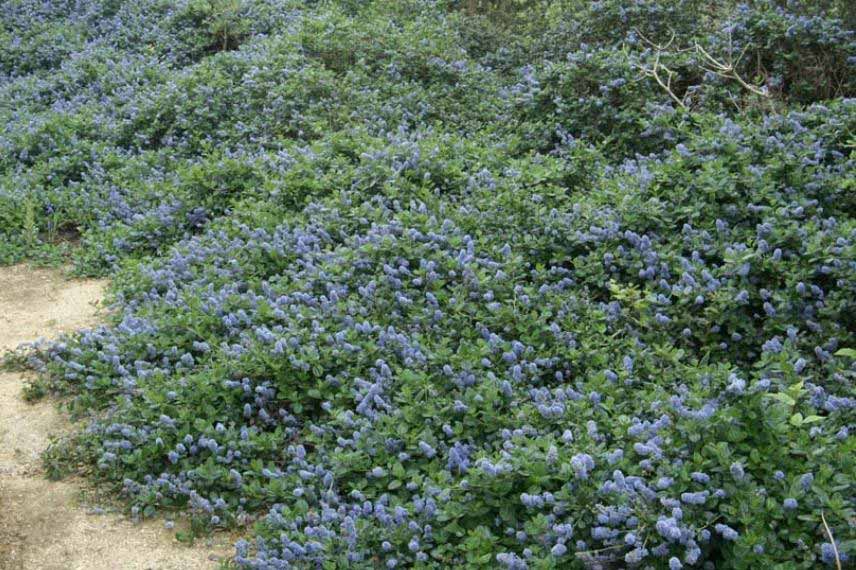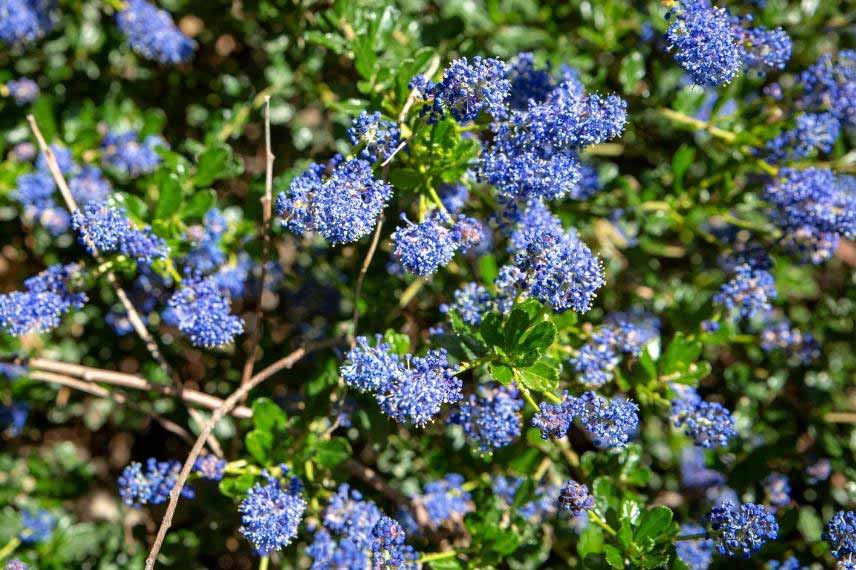
Creeping Ceanothus: the best varieties for slopes
Evergreen California Lilacs to plant as groundcover
Contents
Planted on slopes, creeping bushes adorn them with greenery and brighten them with their colours. They also help to stabilise the soil, and their covering ability limits adventive plants on these slopes where maintenance is not always easy. The Ceanothus, or California Lilac, are among the wonderful groundcovers, with evergreen foliage and unique flowerings, ranging from a myriad of azure blue to blue-violet. Here we have listed the best creeping Ceanothus to plant on slopes, for ever more magnificent spring or summer flowerings.
 Creeping Ceanothus beautifully adorns the slopes
Creeping Ceanothus beautifully adorns the slopes
→ To learn all about Ceanothus, check our complete guide: CEANOTHUS, CALIFORNIA LILAC: PLANTING, MAINTENANCE, PRUNING
Ceanothus prostratus
Ceanothus prostratus is one of the most spreading and low-growing California Lilacs. Its low height of 40cm makes it suitable for use in the foreground or in areas of slopes where ground cover is desired. It forms a dark green carpet with dense foliage, completely covering the soil over more than 2m.
In spring, it is adorned with a magnificent blanket of light blue to lavender flowers grouped in panicles at the tips of the branches. Highly melliferous and fragrant, they happily attract bees. Once flowering is complete, it is followed by the formation of seeds that are scattered around upon ripeness. The leaves are small (1 to 3 cm), glossy, and a fairly dark green.
Hardy down to -10°C, the Ceanothus prostratus is originally a wild Ceanothus from the United States. It is suited to well-drained soils, which can be either dry or moist in summer. It prefers a sunny or partially shaded position and will thrive better sheltered from cold winds. Planting on slopes is ideal for this ceanothus. A light pruning after flowering will encourage its branching for a dense cover of the area to be vegetated.

Ceanothus prostratus
Ceanothus thyrsiflorus 'Repens'
With its gracefully arching, trailing branches, Ceanothus thyrsiflorus ‘Repens’ is an ideal candidate to beautifully dress any slope lacking greenery. Its ground-hugging habit allows it to spread, albeit slowly, to cover areas of about 1m to 1.5m. Its foliage is dark green, glossy on top and fluffy underneath. It consists of small ovate leaves measuring 3 to 4 cm, fully covering the plant; an excellent, dense groundcover that is also evergreen.
When May warms the atmosphere and the days noticeably lengthen, it is adorned with a beautiful profusion of characteristic flowers gathered in small clusters. Their azure blue colour is simply spectacular and always amazes onlookers, including the most seasoned gardeners. A bit ephemeral, it will last until June, but the evergreen foliage of this Ceanothus makes it interesting all year round for greening slopes.
The Ceanothus thyrsiflorus ‘Repens’ is an easy shrub to grow: it is planted in spring or autumn (especially in the south), in rather fertile and very well-drained soil, in full sun or partial shade. This Californian lilac tolerates slightly calcareous soils and can withstand winter temperatures down to -10°C.

Ceanothus thyrsiflorus ‘Repens’
Discover other Ceanothus
View all →Available in 1 sizes
Available in 0 sizes
Available in 1 sizes
Available in 3 sizes
Available in 3 sizes
Available in 0 sizes
Available in 1 sizes
Available in 1 sizes
Available in 2 sizes
Available in 1 sizes
Ceanothus griseus 'Yankee Point'
The Ceanothus griseus var. horizontalis ‘Yankee Point’ is a California Lilac whose spreading branches overlap in successive strata to form a thick groundcover mass. Its abundant flowering, in a deep blue, blooms in April. Remarkably fragrant, it attracts numerous bees, bumblebees, and certain butterflies.
Its main advantage is that it is very undemanding regarding soil type: it can therefore be planted on a slope where establishing more demanding plants is difficult. As with other Ceanothus, the condition sine qua non for its cultivation will be to allow it to grow in well-drained soil. Vigorous, it will form a mass of 1.00 m in height and 3.00 m in spread within a few years, covering the surface with its dense and evergreen foliage.
Plant it in full sun; it is particularly drought-resistant and tolerates negative temperatures down to -10°C in well-drained soil.

The Ceanothus griseus ‘Yankee Point’
Ceanothus 'Blue Diamond'
For a darker and more intense blue flowering, opt for the Ceanothus hybrid ‘Blue Diamond’. It appears in May, like many California Lilacs, in fragrant clusters that irresistibly attract pollinating insects. They completely cover the plant, almost masking its beautiful glossy evergreen foliage.
When you plant it on a slope, it will thrive as groundcover due to its bushy and spreading habit, reaching 90cm in height and spreading 1.30m wide. Be sure to drain the planting hole if the soil is compact and clayey.
It is a bush that requires very little maintenance and grows effortlessly when its few needs are met: in full sun or partial shade, in well-drained and rather poor soil, with a neutral pH. Avoid exposing it to cold drafts, and it will withstand winter temperatures down to -10°C.
 Ceanothus ‘Blue Diamond'[/caption>
Ceanothus ‘Blue Diamond'[/caption>
Ceanothus 'Blue Sapphire'
An exceptional and fast-growing Ceanothus ‘Blue Sapphire’! It obviously takes its name from its flower colour, which is simply incredible. It will be the focal point of the slope where it is planted, alongside other creeping bushes or planted in masses to enhance the striking effect of its intense blue flowering. For a California lilac, this flowering is particularly long as it lasts for several weeks, from April to July.
Its bushy and creeping character makes it suitable for planting as groundcover on the slopes of a bank, perhaps even by the sea, as it withstands salt spray and drought perfectly.
Its evergreen foliage will look wonderful all year round; be sure to plant it in full sun (or partial shade in hot regions), in well-drained soil, of course. Once mature, this variety will reach a height of 1.00 m with a spread of 1.50 m and will withstand short frosts down to -10°C.
 Ceanothus ‘Blue Sapphire'[/caption>
Ceanothus ‘Blue Sapphire'[/caption>
Ceanothus 'Blue Mound'
Ceanothus hybrid ‘Blue Mound’ is a larger spreading groundcover than the previous ones: reaching about 1.5 m in height and 2 m in spread at maturity, it will quickly develop to cover a slope, even a steep one.
Naturally spreading, it extends compact branches, densely covered with small dark green evergreen leaves. In May and June, the tips of its branches are adorned with a multitude of small bright blue flower clusters. Slightly fragrant and melliferous, they attract pollinating insects.
Ceanothus ‘Blue Mound’ will thrive in full sun in light, well-drained, slightly alkaline soil, sheltered from cold winds. While it prefers regions with a mild climate, it can nonetheless without excessive moisture. Easy and drought-resistant, it is an ideal candidate for greening and enlivening a slightly bare slope with its flowering.
 Ceanothus ‘Blue Mound'[/caption>
Ceanothus ‘Blue Mound'[/caption>
- Subscribe!
- Contents










































Comments